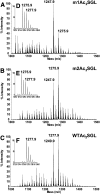Deciphering sulfoglycolipids of Mycobacterium tuberculosis
- PMID: 21482713
- PMCID: PMC3090231
- DOI: 10.1194/jlr.M013482
Deciphering sulfoglycolipids of Mycobacterium tuberculosis
Abstract
For 4 decades, in vivo and in vitro studies have suggested that sulfoglycolipids (SGLs) play a role in the virulence or pathogenesis of the tubercle bacilli. However, the SGL structure and biosynthesis pathway remain only partially elucidated. Using the modern tools of structural analysis, including MALDI-time-of-flight MS, MS/MS, and two-dimensional NMR, we reevaluated the structure of the different SGL acyl (di-, tri-, and tetra-acylated) forms of the reference strain Mycobacterium tuberculosis H37Rv, as well as those produced by the mmpL8 knockout strains previously described to intracellularly accumulate di-acylated SGL. We report here the identification of new acyl forms: di-acylated SGL esterified by simple fatty acids only, as well as mono-acylated SGL bearing a hydroxyphthioceranoic acid, which were characterized in the wild-type strain. In a clinical strain, a complete family of mono-acylated SGLs was characterized in high abundance for the first time. For the mmpL8 mutant, SGLs were found to be esterified i) by an oxophthioceranoic acid, never observed so far, and ii) at nonconventional positions in the case of the unexpected tri-acylated forms. Our results further confirm the requirement of MmpL8 for the complete assembly of the tetra-acylated forms of SGL and also provide, by the discovery of new intermediates, insights in terms of the possible SGL biosynthetic pathways.
Figures







References
-
- Goren M. B., Brokl O., Das B. C., Lederer E. 1971. Sulfolipid I of Mycobacterium tuberculosis, strain H37Rv. Nature of the acyl substituents. Biochemistry. 10: 72–81. - PubMed
-
- Goren M. B. 1970. Sulfolipid I of Mycobacterium tuberculosis, strain H37Rv. I. Purification and properties. Biochim. Biophys. Acta. 210: 116–126. - PubMed
-
- Goren M. B. 1970. Sulfolipid I of Mycobacterium tuberculosis, strain H37Rv. II. Structural studies. Biochim. Biophys. Acta. 210: 127–138. - PubMed
Publication types
MeSH terms
Substances
LinkOut - more resources
Full Text Sources
Other Literature Sources
Medical

